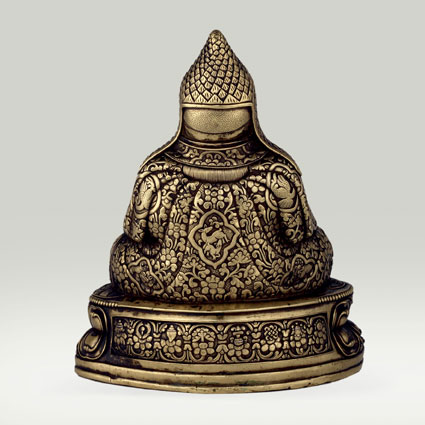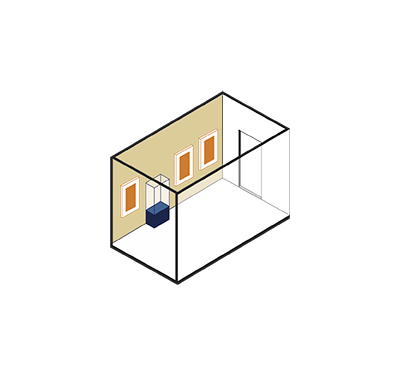ABS 177
Code: ABS 177
Country: Tibet
Style:
Date: 1400
Dimensions in cm WxHxD: 13.8 x 16.3 x 10.2
Materials: Brass; extensively inlaid with silver and copper
(Tib. Dol-po-pa Shes-rab rgyal-mtshan)
Cast in one piece, partly hollow.
The monastic robes, the hat and the back of the pedestal are prominently decorated with ornaments worked in an unusual relief fashion and extensively inlaid with silver and copper.
The face retains traces of painted cold gold.
The bottom of the pedestal is sealed with a plain sheet of copper.
Only rarely is it possible to attribute a Tibetan sculpture to a particular workshop. An exception is this statue of Dol po pa Shes rab rgyal mtshan, an eccentric monk from Dolpo. This statue represent an example of the Byang lugs, or “northern style’, of western gTsang in Southern Tibet distinguished by a strong realism.
This image of a monk with facial expressions of a portrait-like character, is according to David P. Jackson representations of Dol po pa Shes rab rgyal mtshan (1292-1361) as shown on a xylograph. He is seated in the diamond attitude (vajraparyankasana) on a double lotus pedestal with an upper beaded border; he rests the right hand on the leg, and in the left he holds a rosary (aksamala); and he is clad in an array of monastic garments (civara) decorated with floral and geometric patterns and wears a hat. the back of the pedestal is decorated with the astamangala emblem (Tib. bKra shis rtags brgyad), or the " collection of eight auspicious objects". These are interpreted in many different ways in Hindu, Jaina and Buddhist traditions. According to Tibetan Buddhism, they consist of the cakra, chattra, dhvaja, kalasa, matsyayugma, padma, sankha, and srivatsa (Skt.) Bum pa, dPal be, Dung, gDungs, gSer na, rGyal mtshan, 'Khor lo, and Padma(Tib.) On the front of dol po pa's robe the Kalacakra anagram (Tib.rnam bcu dbang ldan) is written in Lancana script. This statue is an example of the Byang metal working tradition.
There are two almost identical images of Dol po pa Shes rab rgyal mtshan (1292-1361) in the Jo khang/g Tsung lag khang Collection (Pl.328C-F). These may represent examples of the Byang metal working tradition which is distinguished by a strong realism and can include ornamentation in relief work. The two statues of Dol po pa are of almost identical size and also very similar in many other aspects. The dissimilarity in the ornamentation is a proof that both statues where modelled by hand, and the use of matrices can be ruled out. An ornamentation similar in many respects decorates the robe of an image of Thang stong rgyal po (1361-1485 or 1385-1464), who according to its inscription made the statue himself. All three statues certainly belong to the same artistic tradition and one might be tempted to attribute the two statues of Dol po pa also to the workshop of Thang stong rgyal po. Considering that Thang stong rgyal po was born in the year of Dol po pa Sher rab rgyal mtshan's death, and that he is considered to be a reincarnation of the latter, such an assumption would not be out of reach. Both eccentric masters were active in the Byang region of Southern Tibet, where between 1330 and 1333 Dol po pa buitl a monumental...
Dolpopa Sherab Gyaltsen (Tibetan: Dol-po-pa Shes-rab Rgyal-mtshan)
(1292-1361), known simply as Dolpopa, the Tibetan Buddhist master known as "The Buddha from Dolpo," is often seen as the founder of the Jonangpa tradition of Tibetan Buddhism. However, the doctrinal origins of the Jonangpa tradition in Tibet can be traced to early 12th century master Yumo Mikyo Dorje, but they became much wider known with the help of Dolpopa Sherab Gyaltsen.
He was born in the Dolpo region of modern Nepal but in 1309, when he was seventeen, he ran away from home to seek Buddhist teachings, first in Mustang, and then in Tibet.
Dolpopa became one of the most influential and original Tibetan teachers. Originally a monk of the Sakya order, he developed a teaching known as Shentong or Zhentong (gzhan song), which is closely tied to the Indian Yogacara school. He is considered to be one of the greatest exponents of the Kalachakra or "Wheel of Time" and a "consummate practitioner" of the Six Yogas:
"It is important to keep in mind that Dolpopa was a consummate practitioner of the Six-branch Yoga, the perfection-stage practices of the Kalacakra tantra, and although he based his doctrinal discussions upon scripture, in particular the Kalacakra-related cycles, his own experience in meditation was crucial to the formulation of his theories."
In 1314, when he was twenty-two years old, Dolpopa received full monastic ordination from the famous abbot of Chölung Monastery, Sönam Trakpa (1273-1352), and made a vow at the time to never eat slaughtered meat again.
In 1321, Dolpopa visited the monastery of Jonang for the first time. He then visited Tsurphu Monastery for the first time and had extensive discussions with Rangjung Dorje, the third Karmapa, about doctrinal issues. It appears that Rangjung Dorje almost certainly influenced the development of some of Dolpopa's theories, possibly including his Shentong method. Other than this, he had studied almost completely under the Sakya tradition until he was thirty years old in 1322, and he had taught for most of the previous decade at the great Sakya Monastery.
In 1327, after the death of his guru Yönden Gyantso, Dolpopa decided to fulfill a prayer he had made at the great stūpa at Trophu (Khro phu) to repay his master's kindness. "He also felt that the stupa would become an object of worship for people who were not fortunate enough to engage in study, contemplation, and meditation, and therefore provide them with the opportunity to accumulate virtue."
In 1329 a large stupa was quickly built at upper Zangden (Bzang ldan), but it collapsed. In 1330 the foundations for a much larger stupa were laid at a new site in lower Zangden. It was a massive undertaking and involved many workers and artisans. Support flowed in from around Tibet. It was finally consecrated in 1333 and was the largest stupa temple (sku 'bum) in Tibet.
After the construction of the stupa, he spent many years studying and in meditation retreat. He became widely recognized as one of the great Buddhist masters of Tibet. Many offerings were sent to him including gold from Sakya Tishri Kunga Gyaltsen, and a golden mandala from Rangjung Dorje.
The entire corpus of Dolpopa's writings, which include his controversial definition of the Buddhist concept of sunyata (usually translated as "emptiness" or "voidness") as being two-fold, including "emptiness of self-nature" applying only to relative truth, while absolute truth was characterized by "emptiness of other" (i.e. ultimate Reality is not empty of its own uncreated and deathless Truth, but only of what is impermanent and illusory), was completely suppressed by the dominant Gelukpa order for several hundred years, although it is sometimes claimed that this suppression was equally for political reasons as doctrinal.
Dolpopa retired from the leadership of Jonang Monastery in 1338, and appointed the translator (Lotsawa) Lödro Bal to succeed him. Lödro Bal remained in this role for seventeen years.
Bock, Etienne; Falcombello, Jean-Marc; Jenny Magali, 2022. Trésors du Tibet. Sur les pas de Milarépa.. Paris: Flammarion. P. 262-263
Cornu, Philippe , 2001. Dictionnaire Encyclopédique du Bouddhisme. Seuil. P. 178 - Compare with an image of Dolpopa Sherab Gyaltsen
Stearns, Cyrus , 1999. The Buddha from Dolpo: A Study of the Life and Thought of the Tibetan Master Dolpopa Sherab Gyaltsen. . Albany, N.Y: State University of New York Press.
von Schroeder, Ulrich, 2001. Buddhist Sculptures in Tibet. Vol. One: India & Nepal; Vol. Two: Tibet & China. Hong Kong: Visual Dharma Publications, Ltd.. Vol. Two: Tibet & China; pp. 1202 - 1203, pls. 328 C-F - Compare with an image of Dolpopa Sherab Gyaltsen
von Schroeder, Ulrich, 2010. Buddhist Sculptures of the Alain Bordier Foundation. Hong Kong: Visual Dharma Publications, Ltd.. Pp. 46–47; plate 20B






